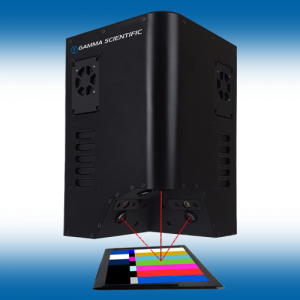



The GS-1163 multi-view angle display spectrometer is designed to measure color and luminance at three different angles simultaneously. As part of the Vector line of multi-view angle display spectrometers, the system integrates a flicker sensor and three spectrometers into one module at -60, 0, and 60 degrees for high-speed and accurate concurrent spectral measurements. Its innovative technology is superior to filter-based colorimeters and not susceptible to filter matching errors.
The system delivers true spectral based measurement accuracy that is required for high color saturation and wide color gamut OLED, micro LED and quantum dot displays. LightTouch uSpectrum and uFlicker software provide comprehensive color and flicker measurements and analysis.
Simultaneous Multi-View Display Characterization
Features
- Simultaneous color and luminance measurements at three different angles (-60, 0, and 60 degrees)
- Luminance, CIE 1931 x, y, CIE 1976 u, v, CIE 1931 XYZ, peak dominant wavelength, SPD and CCT
- Integrated flicker sensor: 100K samples/second
- Powerful MCU for high-speed measurements and data output
- Mechanical and electronic shutter
- USB 2.0 and RS-232 SCPI command compliant and SDK/API library support
- Windows and MAC OSX compatible
- Laser positioning

Measurement System | ||
Sensor | CMOS linear image sensor | |
Wavelength Range | 380 to 780 nm | |
Wavelength Data Increment | 1 nm | |
Number of Angles | 3 angles, -60/0/60 degrees | |
Measurement Spot Size | 12 nm at 65 mm distance at 0 degrees | |
Wavelength Reproducibility | ± 1nm *6 | |
Spectrum – Single Angle Measurement Specifications | ||
| Luminance *1*2 | Measurement range | 0.005~5,000 cd/m2 |
| Accuracy | ± 1.5% 100 to 5,000 cd/m2 | |
| ± 2% 0.2 to 100 cd/m2 | ||
| ± 4% 0.05 to 0.2 cd/m2 | ||
| ± 8% 0.005 to 0.05 cd/m2 | ||
| Repeatability (2σ)*3 | 0.2% 100 to 5,000 cd/m2 | |
| 0.5% 0.2 to 100 cd/m2 | ||
| 0.8% 0.05 to 0.2 cd/m2 | ||
| ± 8% 0.005 to 0.05 cd/m2 | ||
| Color *1*2 | Measurement range | 0.01~5,000 cd/m2 |
| Accuracy | ±0.002 in CIE 1931 x,y for white 100 to 5,000 cd/m2 | |
| ±0.002 in CIE 1931 x,y for white 0.2 to 100 cd/m2 | ||
| ±0.003 in CIE 1931 x,y for white 0.05 to 0.2 cd/m2 | ||
| ±0.006 in CIE 1931 x,y for white 0.01 to 0.05 cd/m2 | ||
| Repeatability (2σ)*3 | 0.0005 in CIE1931 x,y for white 100 to 5,000 cd/m2 | |
| 0.001 in CIE 1931 x,y for white 0.2 to 100 cd/m2 | ||
| 0.002 in CIE 1931 x,y for white 0.05 to 0.2 cd/m2 | ||
| 0.006 in CIE1931 x,y for white 0.01 to 0.05 cd/m2 | ||
Stray Light | -25 dB max *4 | |
| Polarized Error | < 2% | |
Integration Time Range | 100 μs to 5,000 ms (fast mode/normal mode) | |
| Measurement Speed *5 | 1 to 2 samples/S for Y at 0.5 cd/m2 | |
| 15 to 30 samples/S for Y at 10 cd/m2 | ||
| 20 to 30 samples/S for Y at 50 cd/m2 | ||
| 20 to 30 samples/S for Y at 100 cd/m2 | ||
Digital Resolution | 16 bits | |
Flicker | ||
| Measurement Range | 5 to 5,000 cd/m2 | |
| Sampling Rate | 100k sample/sec (adjustable) | |
| Contrast | Accuracy | ±1% (30Hz AC/DC 10% sine wave) |
| ±2% (60Hz AC/DC 10% sine wave) | ||
| Reproductibility | 1% (20 to 65 Hz AC/DC 10% sine wave) | |
| JEITA | Accuracy | ±0.5dB (30Hz AC/DC 10% sine wave) |
| Reproducibility | ±0.3dB (30 Hz AC/DC 10% sine wave) | |
Features | ||
| Capture Function | One time/Continuous | |
| Operation Mode | 1. USB 2.0: High speed device, using LightTouch uSpectrum library | |
| 2. RS-232: For PC and embedded purposes, using SCPI command | ||
| Integration Mode | Auto/Manual | |
| Dark Calibration | Yes (auto) | |
| Measuring Parameters (Flicker) | Max/Min, Average, RMS, Frequency, JEITA, VESA, Flicker Percentage (IES), and Flicker Index (IES) | |
System Configuration | ||
| Dimensions | 240 x 216.5 x 136.3 mm (H x W x D) | |
| Weight | 3.8 ± 0.2 kg | |
*1 Luminance and color testing are based on standard light source at 2856K, 6500K and 9300K.
*2 Measure in normal mode with temperature 23±2 °C and relative humidity 50% or less
*3 Repeatability test is based on the status of shutter opening
*4 Input the 550nm monochromatic light and measure the stray light ratio at 550nm ± 40nm
*5 Testing condition: Sync mode at 60Hz. Sample speed depends on the measured sample. If the sample uses PWM, it will take longer

